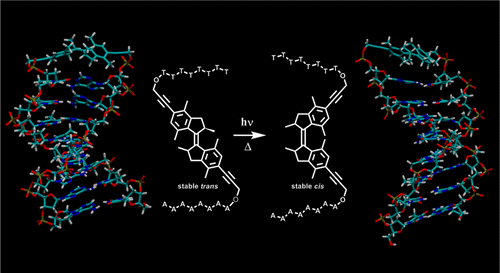当前位置:
X-MOL 学术
›
J. Am. Chem. Soc.
›
论文详情
Our official English website, www.x-mol.net, welcomes your
feedback! (Note: you will need to create a separate account there.)
Photoswitching of DNA hybridization using a molecular motor
Journal of the American Chemical Society ( IF 14.4 ) Pub Date : 2018-03-18 , DOI: 10.1021/jacs.7b09476 Anouk S Lubbe 1 , Qing Liu 2 , Sanne J Smith 2 , Jan Willem de Vries 2 , Jos C M Kistemaker 1 , Alex H de Vries 2, 3 , Ignacio Faustino 3 , Zhuojun Meng 3 , Wiktor Szymanski 1, 4 , Andreas Herrmann 2, 5, 6 , Ben L Feringa 1
Journal of the American Chemical Society ( IF 14.4 ) Pub Date : 2018-03-18 , DOI: 10.1021/jacs.7b09476 Anouk S Lubbe 1 , Qing Liu 2 , Sanne J Smith 2 , Jan Willem de Vries 2 , Jos C M Kistemaker 1 , Alex H de Vries 2, 3 , Ignacio Faustino 3 , Zhuojun Meng 3 , Wiktor Szymanski 1, 4 , Andreas Herrmann 2, 5, 6 , Ben L Feringa 1
Affiliation

|
Reversible control over the functionality of biological systems via external triggers may be used in future medicine to reduce the need for invasive procedures. Additionally, externally regulated biomacromolecules are now considered as particularly attractive tools in nanoscience and the design of smart materials, due to their highly programmable nature and complex functionality. Incorporation of photoswitches into biomolecules, such as peptides, antibiotics, and nucleic acids, has generated exciting results in the past few years. Molecular motors offer the potential for new and more precise methods of photoregulation, due to their multistate switching cycle, unidirectionality of rotation, and helicity inversion during the rotational steps. Aided by computational studies, we designed and synthesized a photoswitchable DNA hairpin, in which a molecular motor serves as the bridgehead unit. After it was determined that motor function was not affected by the rigid arms of the linker, solid-phase synthesis was employed to incorporate the motor into an 8-base-pair self-complementary DNA strand. With the photoswitchable bridgehead in place, hairpin formation was unimpaired, while the motor part of this advanced biohybrid system retains excellent photochemical properties. Rotation of the motor generates large changes in structure, and as a consequence the duplex stability of the oligonucleotide could be regulated by UV light irradiation. Additionally, Molecular Dynamics computations were employed to rationalize the observed behavior of the motor–DNA hybrid. The results presented herein establish molecular motors as powerful multistate switches for application in biological environments.
中文翻译:

使用分子马达进行 DNA 杂交的光开关
通过外部触发对生物系统功能的可逆控制可用于未来的医学,以减少对侵入性手术的需求。此外,由于其高度可编程的性质和复杂的功能,外部调节的生物大分子现在被认为是纳米科学和智能材料设计中特别有吸引力的工具。在过去几年中,将光开关结合到生物分子(如肽、抗生素和核酸)中已经产生了令人兴奋的结果。由于分子马达的多态切换周期、单向旋转和旋转步骤中的螺旋反转,分子马达为新的和更精确的光调节方法提供了潜力。在计算研究的帮助下,我们设计并合成了一个可光切换的 DNA 发夹,其中分子马达作为桥头单元。在确定运动功能不受连接器刚性臂的影响后,采用固相合成将电机整合到 8 个碱基对的自互补 DNA 链中。光开关桥头就位后,发夹的形成没有受到影响,而这种先进的生物混合系统的电机部分保留了出色的光化学特性。电机的旋转会产生较大的结构变化,因此寡核苷酸的双链稳定性可以通过紫外线照射进行调节。此外,采用分子动力学计算来合理化观察到的马达-DNA 杂交体的行为。
更新日期:2018-03-18
中文翻译:

使用分子马达进行 DNA 杂交的光开关
通过外部触发对生物系统功能的可逆控制可用于未来的医学,以减少对侵入性手术的需求。此外,由于其高度可编程的性质和复杂的功能,外部调节的生物大分子现在被认为是纳米科学和智能材料设计中特别有吸引力的工具。在过去几年中,将光开关结合到生物分子(如肽、抗生素和核酸)中已经产生了令人兴奋的结果。由于分子马达的多态切换周期、单向旋转和旋转步骤中的螺旋反转,分子马达为新的和更精确的光调节方法提供了潜力。在计算研究的帮助下,我们设计并合成了一个可光切换的 DNA 发夹,其中分子马达作为桥头单元。在确定运动功能不受连接器刚性臂的影响后,采用固相合成将电机整合到 8 个碱基对的自互补 DNA 链中。光开关桥头就位后,发夹的形成没有受到影响,而这种先进的生物混合系统的电机部分保留了出色的光化学特性。电机的旋转会产生较大的结构变化,因此寡核苷酸的双链稳定性可以通过紫外线照射进行调节。此外,采用分子动力学计算来合理化观察到的马达-DNA 杂交体的行为。









































 京公网安备 11010802027423号
京公网安备 11010802027423号